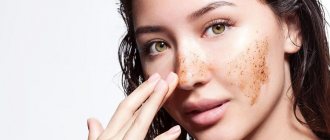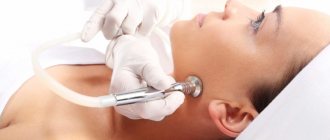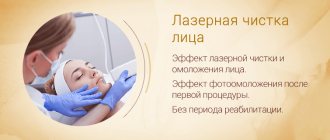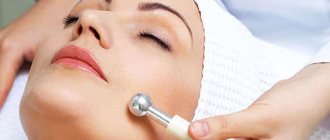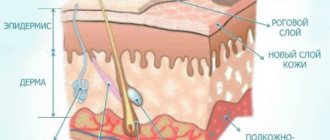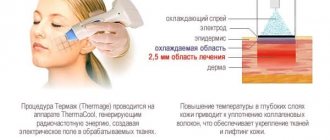Manual mechanical facial cleansing is an effective cosmetic procedure that will help preserve the natural beauty, health and youth of the skin. Cleaning of the skin is carried out manually by a specially trained specialist. The result of the technique is noticeable after just a few sessions: the skin becomes smooth, matte, takes on a fresh, beautiful appearance, the pores are cleared of impurities, and the functioning of the sebaceous glands is normalized. Manual cleaning is absolutely safe, suitable for all skin types, and can be carried out during pregnancy, as it does not cause any harm to the body.
The International Hemostasis Clinic employs professional cosmetologists who perform mechanical facial cleansing efficiently and effectively, taking into account the individual characteristics of the patient’s skin. After the first session, you will be able to evaluate the results and admire the reflection in the mirror.
Description of the mechanical cleaning procedure
Manual facial cleansing will help cleanse the skin of excess fat, keratinized epithelium, blackheads, acne and other impurities that spoil a person’s appearance. The procedure is carried out in a cosmetology office by a specially trained cosmetologist, who is obliged to strictly follow the technique of performing the manipulations.
For patients with oily skin, manual cleaning is recommended once every 7–10 days, and for normal skin types, no more than once a month. The total duration of the session is on average 1.5 – 2 hours. It all depends on the condition of the skin, the severity of cosmetic defects.
Immediately after the session, redness, slight swelling, and irritation may appear on the treated skin. These symptoms are considered normal and disappear after 12 to 24 hours without special treatment. If the dermis is thin, sensitive, and prone to inflammation, side effects in the form of hyperemia and swelling may persist for 2 to 3 days. During this period, it is important to strictly follow the cosmetologist’s recommendations regarding rehabilitation. After cleansing, it is forbidden to use decorative cosmetics for the first 3 to 5 days, and the skin of the face must be protected with individually selected care products.
Manual facial cleansing (Uno spoon) 4000 rub. Appointment with a cosmetologist, subject to the provision of services on the day of consultation 2,000 rubles.
All prices Make an appointment
A few days after the procedure, the surface layers of the epidermis begin to die and peel off. Outwardly, this manifests itself as slight peeling, which quickly disappears with regular use of moisturizing cosmetics. At the same time, natural processes of regeneration of dermal cells are launched, which contributes not only to cleansing, but also to effective rejuvenation of the skin.
Advantages and disadvantages of facial cleansing in a salon
Facial cleansing in a salon deprives the massage, the opportunity to improve your appearance and the opportunity to relax. After salon treatments, facial skin becomes radiant, fresh and in a great mood. Among the benefits of peeling are:
- improving blood circulation in the skin;
- removal of toxins;
- removal of blackheads, small scars, smoothing of small facial wrinkles;
- normalization of the sebaceous glands;
- activation of collagen and elastin production.
Almost after 1-3 procedures the result is visible, it all depends on the problem of the skin. The disadvantages include:
- the need to adhere to certain rules of facial care after the procedure (especially washing, using powder, foundation);
- the need to undergo a rehabilitation period (certain types of peeling cannot be done before the start of an important event);
- ban on sunbathing for a certain period or for a long period;
- some types are characterized by trauma or have an increased risk of complications.
Some types of peeling can be performed at home (vacuum, mechanical), but in order to avoid complications, it is necessary to have your face cleaned by a professional cosmetologist.
Indications for manual facial cleansing
Manual facial cleansing is suitable for any skin type, but the most pronounced effect will be observed by those with oily, porous, inflammation-prone dermis. The main indications for the procedure are:
- enlarged pores;
- increased activity of the sebaceous glands;
- tendency to numerous rashes, acne;
- decreased skin tone;
- wen, milia and other dermatological defects;
- blackheads prone to inflammation;
- uneven surface of the skin;
- boils.
The technique combines well with ultrasound cleansing, which does not always allow high-quality cleansing of the skin from coarse keratinized tissues and deeply located comedones. Therefore, manual cleaning is carried out only on heavily contaminated areas of the face. All other areas are treated with an ultrasound device, which effectively removes surface impurities, dead cells, pigment spots, and swelling.
Manual cleaning goes well with the vacuum method. Pre-treatment of the skin with vacuum attachments promotes good opening of pores and sebaceous glands, due to which, during manual cleaning, the skin is effectively freed from dead epithelium and impurities that cause inflammation.
Contraindications to manual facial cleansing
Despite the fact that manual skin cleansing has proven itself to be a safe, painless procedure, it still has its limitations, which cannot be ignored. To identify contraindications, before manipulation, the cosmetologist conducts a thorough external examination, collects anamnesis, and asks about disturbing symptoms.
Manual cleaning is contraindicated for patients diagnosed with the following pathologies and disorders:
- viral and chronic skin diseases;
- profuse acne, accompanied by severe inflammation, suppuration, hyperemia;
- thinned, very dry skin;
- fragile vessels;
- phlebeurysm;
- thrombophlebitis;
- chronic arterial hypertension;
- rosacea;
- demodicosis - damage to the skin by the microscopic Demodex mite;
- allergic rashes;
- critical days;
- diseases of the hematopoietic system;
- acute cardiac, pulmonary, renal failure;
- oncological neoplasms of any location;
- severe mental disorders accompanied by uncontrollable attacks and seizures.
Pros and cons of the procedure
The main advantages of manual mechanical cleaning:
- The skin is noticeably rejuvenated. During the procedure, intensive exfoliation of the upper keratinized layer of the epidermis occurs and at the same time natural regeneration processes are activated. Thanks to this effect, the skin rejuvenates, becomes fresher, smoother, and radiant.
- The pores become narrower. Manual manipulations effectively cleanse pores of impurities, sebaceous plugs, blackheads, comedones, and blackheads. Also, after the procedure, blood circulation and metabolism improve, the functioning of the sebaceous glands is normalized, which leads to narrowing of pores and leveling of the microrelief.
- The number of inflammatory elements decreases. After manual cleaning, foci of inflammation disappear, which significantly reduces the risk of scarring, age spots, and post-acne.
- The permeability of the dermis improves. Thanks to this effect, the active ingredients contained in skin care cosmetics penetrate efficiently into the cells of the epidermis, nourishing them, saturating them with vitamins and other beneficial substances.
- Skin breathing improves. During the procedure, the cosmetologist removes dead skin cells, which helps open pores and improve skin respiration.
- Evening out complexion. Due to the exfoliating effect, mechanical cleaning will help get rid of this problem. Some time after the procedure, the skin will acquire an even, beautiful, healthy shade.
The technique has disadvantages, the most significant of which are:
- Pain during manipulation. Despite the fact that during the procedure the cosmetologist makes neat, careful movements, for people with a high sensitivity threshold, even such manipulations can cause discomfort.
- Injury to the skin and blood vessels. Mechanical compression can cause injury to the skin, especially if it is dry and depleted. Manual cleaning is not carried out for patients with fragile, brittle vessels, since during manipulation there is a risk of damaging them.
- Development of inflammation and scarring. If the patient has inflamed elements or ulcers on his face, cleaning is prohibited in order to avoid the spread of the infectious process. Scars occur when the skin is severely injured, which is a consequence of improper manipulation.
- Skin infection. This happens when the cosmetologist does not follow the rules of sterility and disinfection. Pathogenic microflora remaining on hands and instruments can cause serious inflammatory complications and spread throughout the body.
- Need for rehabilitation. Almost always after the procedure, the skin turns red, slight swelling forms, and sometimes bruises. Therefore, the patient needs rehabilitation recovery, during which it is important to follow the cosmetologist’s recommendations and use the care products prescribed by him.
How to choose a beauty salon?
The average cost of a mechanical facial cleansing service is 1600–3000 rubles . Honestly, I think this price is a little high.
Because in the same price range you can do ultrasonic facial cleansing, which is not so painful, but also effectively eliminates imperfections. This is for those who do not tolerate pain very well.
However, mechanical facial cleansing is a procedure that appeared almost among the first on the skin care services market. It has an aggressive effect on it, and a competent specialist will bring the skin to ideal condition.
Here is a photo before the second cleaning, the result is already quite good:
On the Internet you can find a lot of offers from beauty salons that offer mechanical facial cleansing services, especially in large cities.
Depending on your financial capabilities, you can select a specialist. You can also consult with acquaintances or friends who visit a cosmetologist, perhaps they will help with choosing a specialist.
Preparation and carrying out the procedure
The technique of manual facial cleansing includes the following steps:
- Preparation. Before all manipulations, the face is cleansed of decorative cosmetics, dust, sebum and other contaminants. To do this, the cosmetologist uses professional products in the form of gels, foams, lotions, etc. If the skin is heavily soiled, an additional scrubbing procedure is performed. To open the pores as much as possible, the cosmetologist steams the skin using a vaporizer, paraffin mask or special thermogel.
- Direct cleaning. At this stage, the skin is thoroughly cleansed of impurities, acne, blackheads, comedones, and sebaceous plugs. The specialist carefully examines each area of the face. To remove impurities, he presses on the skin with his fingertips, which are tightly wrapped in sterile napkins. The cosmetologist also uses a special tool that captures even the deepest sebum plugs that hardware and laser procedures cannot handle.
- Applying a soothing mask and moisturizer. After all the manipulations, the skin remains irritated and red. To relieve these symptoms, an anti-inflammatory, pigment-constricting mask is applied to the face. Then the face is treated with moisturizing cream.
If the rashes on the face are profuse, additional sessions of mechanical cleansing will be required, because the cosmetologist will not remove all the impurities at one time. In addition, after the pores close, manipulation becomes painful. Therefore, the specialist prescribes a course of procedures aimed at gradually and painlessly getting rid of skin defects.
In order for the injured skin to recover faster, a cosmetologist may advise resorting to the following physiotherapeutic measures:
- darsonvalization;
- iontophoresis;
- cryomassage;
- infrared radiation treatment.
How does a cosmetologist do facial cleansing?
Before you make an appointment with a cosmetologist, you need to understand how facial cleansing is done in a salon. At the first stage, it is necessary to prepare the skin, remove dirt and cosmetics, then, if necessary, do steaming or softening using special gels and creams. Next comes the peeling process itself. At the end of the procedure, a plant-based mask is applied to protect against the inflammatory process. The mask tightens pores and has a calming effect. Then treat with lotion and apply cream.
Facial cleansing in the salon includes the use of various hardware, mechanical or acid methods, which provides an anti-inflammatory, rejuvenating effect.
Vacuum
Vacuum cleansing of facial skin in a salon is done using a special device with a nozzle under air pressure. The device works like a vacuum cleaner, drawing in microparticles of the stratum corneum of the skin.
Before starting the procedure, the skin is cleansed of decorative cosmetics and impurities. Next, it is treated under steam to heat the pores. After this stage, the device is carried out along the massage lines for 20 minutes. In this case, different attachments are used for different parts of the body. Vacuum cleaning is carried out not only for the face, but also for the neck and décolleté area. Finish with a mask to tighten pores or use an ice cube.
This technique does not affect the deep layers of the skin, so it can be done often. The vacuum technique is used for acne and to combat blackheads. Vacuum cleaning improves blood circulation and lymph flow in the skin, reduces facial wrinkles, and evens out facial tone.
Contraindicated in case of rosacea, rosacea, seborrheic dermatitis, pregnancy, or close proximity of capillaries.
Mechanical
Mechanical facial cleansing in the salon allows you to get rid of dirt in the pores. After steaming with your hands, using sterile wipes, removes blackheads. A cosmetologist can use different tools:
- strainer;
- spoons with a loop.
Mechanical peeling lasts 20 minutes until the pores are opened; if this time is not enough, then apply hot compresses and continue working. After the procedure, you should not leave the office into cold air for 40 minutes; you must wait for the redness to go away and the pores to narrow.
The procedure causes injury to the dermis; even after soothing masks, irritation occurs on the face. For dry skin types, allergies, herpes, and blood diseases, mechanical cleansing is contraindicated. It is recommended for removing comedones, sebaceous plugs, and blackheads. There are no contraindications during pregnancy.
Interesting! If you do mechanical facial cleansing in the first half of the menstrual cycle, the process will be less painful.
Brushing
As a method of facial cleansing in a salon, clients are offered the brushing procedure. A scrub is applied to the steamed skin. Next, using a device with brushes of different diameters and hardness, the stratum corneum is removed. The speed and direction of movement can be adjusted. Peeling is done along massage lines and takes no more than 15 minutes. Brushing is carried out in courses of 8 sessions, then a 3-month break.
This cosmetic procedure increases cell division of the epidermis. The remaining scrub is soaked with napkins. At the end of the procedure, there is no need for special facial care. Brushing is done for pregnant women and is used frequently.
Brushing is not suitable for solving serious skin problems; for this it is necessary to use other more aggressive methods. Contraindicated for herpes, dermatitis, inflammation. The method is ineffective for the appearance of spider veins and loose skin.
Chemical
Peeling is carried out under local anesthesia. The application of chemicals causes a burn, which results in separation of the papillary skin from the reticular one. Old collagen fibers and elastin cells are burned out, after which new ones are produced. After which a rehabilitation period of 2 months is required, after which the skin becomes smooth and moisturized. Chemical peeling promotes rejuvenation and improves turgor. Procedures are contraindicated for:
- renal and liver failure;
- pregnancy and lactation;
- allergies to chemicals;
- cardiovascular diseases;
- herpes active form.
Chemical peeling should not be done after 40 years, or while taking medications with aspirin. It is not recommended to do it at home, only under the guidance of a professional cosmetologist.
Using low frequency current galvanization
When using current on the skin, fat is removed, epithelial regeneration is improved, blackheads, acne, small wrinkles are removed, skin color and elasticity are improved. Blood circulation, lymph flow, and cell metabolism are also enhanced, and fat production by the sebaceous glands is stabilized. Ideal for sensitive skin. The procedure is painless and does not cause swelling or burns. Not recommended for:
- purulent inflammation;
- cuts and microtraumas in the treated area;
- pregnancy;
- presence of a pacemaker;
- blood diseases.
Before you begin cosmetic peeling, you need to cleanse your skin of impurities and decorative cosmetics. The procedure is done along massage lines using an electrode, which is wrapped in a napkin with disinfectant. The electrode is charged with negative energy. At the end, a restorative agent is applied.
Laser
Laser beams generated by the device are used as a facial cleanser in a salon, and are carried out over the area of the skin where there is a problem. During the procedure, the client experiences a slight pleasant vibration.
Practiced for uneven texture, spider veins, and pigmentation. After the procedure, the flow of the sebaceous glands improves, the size of the pores decreases, and impurities in the pores are removed. There is no risk of infection with laser cleaning. It is not recommended for herpes, pregnancy, purulent pimples, diabetes, acute infectious diseases.
Ultrasonic
The use of a special device, which consists of a metal plate under high-frequency pulses, effectively fights pigmentation, blackheads, blackheads, and improves skin turgor. A gel with aloe or cacti is applied to the surface, then using a cage, the cosmetologist passes the beam, during which old skin cells are removed. At the end of the procedure, they are dried with ozone, then masks are applied to close the pores and a protective cream.
Ultrasonic cleaning improves cellular metabolism, strengthens skin immunity, activates the production of collagen and elastin, and prevents rashes. Contraindicated for:
- arrhythmias;
- pregnancy;
- tumors;
- acute thrombophlebitis.
Used for sensitive dermis, but for oily skin, you must choose a different method.
Effect after the procedure
The first days after the procedure, sebum secretion and peeling may increase. The cleaning effect can be assessed after 5 – 7 days:
- cleaned pores become narrower;
- the skin becomes smooth, elastic, radiant, matte;
- microrelief is leveled;
- greasy shine disappears;
- the functioning of the sebaceous glands is normalized;
- the face looks refreshed and rejuvenated.
What else should you know?
When planning a trip to a cosmetologist, it is worth considering several nuances that I, for example, did not know.
- It is not recommended to visit a specialist during menstruation and a week before it starts. Since at this time the pain threshold is quite high, and the pain from the procedure will be felt several times stronger.
- After mechanical cleaning, you should not exercise or clean for 3 days, as the pores are still open and dust particles can get in.
- The effect of mechanical facial cleansing lives up to expectations, but you should be patient, as at first, especially after the first procedure, it will seem that it has only gotten worse. But after a month, it was after this time that I noticed positive changes.

